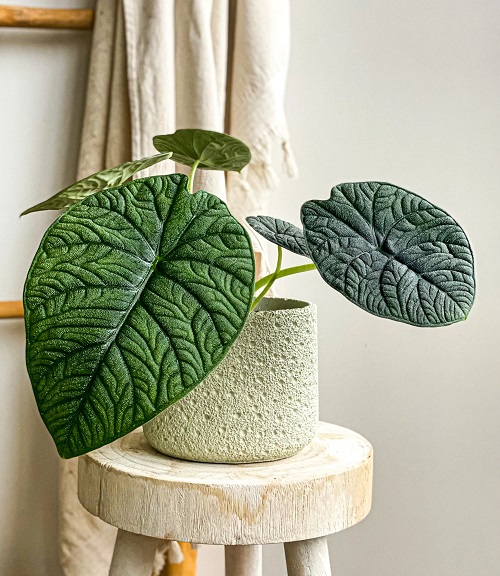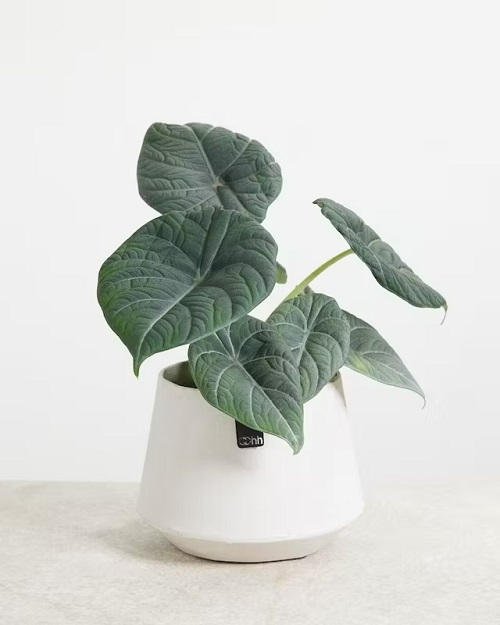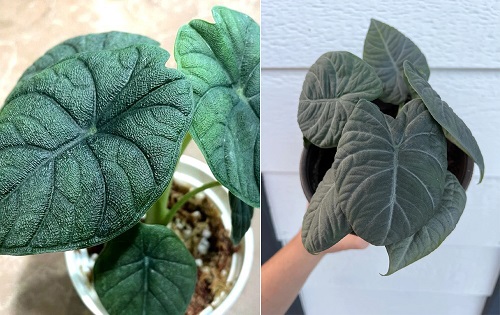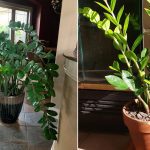Confused about which one to pick—Alocasia Melo Vs. Maharani? Read on for a detailed comparison between the two!
With a compact size, attractive appearance, and low maintenance nature, Alocasia ‘melo’ and ‘maharani’ are a favorite among plant parents. If you are confused between these two tropical beauties, here’s a comparative guide on Alocasia melo vs. maharani. It will help you learn about their unique features and suitability to your preference!
Check Out Some Key Differences Between Baltic and Cebu Blue Pothos here
What is Alocasia Melo?

Alocasia melo, also known as the “Rugosa,” is a unique species of plant in the family Araceae, native to Sabah, Borneo. The plant stands out with its broadly arrow-shaped leaves, growing up to a foot long, and a thicker, rigid texture, as compared to other Alocasia varieties.
The leaves are intricately veined with a rock-like texture to the touch, resembling the skin of a melon—a characteristic that gives the plant its name. With a compact height of 18-24 feet, Alocasia melo makes for a fantastic tabletop or countertop addition.
What is Alocasia Maharani?

Member of the Araceae family, Alocasia maharani is a hybrid between Alocasia reginula and Alocasia rugosa. The plant boasts large, heart-shaped, matte green leaves that have prominent silvery veins running through them. With a moderate height of about 10-14 inches and an elegant appearance, this plant is perfect for novice plant parents.
Alocasia Melo Vs. Maharani—Similarities
Hailing to the same plant family, Alocasia melo and Alocasia maharani share a number of similarities:
- Growth Habit: These plants exhibit a moderate to slow growth rate and are typically compact in their spread.
- Rhizomatous Roots: Like most Alocasias, both melo, and maharani grow from rhizomes. These rhizomes can store food and water, helping the plants withstand less-than-ideal conditions.
- Care Requirements: They require similar growing conditions, preferable well-draining soil, indirect light, and limited watering in their dormant colder months.
- Pest Resistance: Both varieties, thanks to their thick, textured leaves, are resistant to common pests. However, they can still be susceptible to typical issues like spider mites or aphids if their growing conditions are suboptimal.
- Toxicity: As members of the Alocasia genus, ingestion of both cultivars can lead to digestive issues and irritability.
Alocasia Melo Vs. Maharani—Differences

While Alocasia melo and Alocasia ‘maharani’ look somewhat similar, certain features set them apart from each other:
- Origins: While both plants belong to the Alocasia genus, their origins are different. Alocasia melo is a naturally occurring species originating from Borneo. On the other hand, Alocasia ‘maharani’ is a cultivated hybrid and does not have a specific place of origin like naturally occurring species.
- Plant Size: The former reaches a height of about 18-24 inches, while the maharani cultivar is a more compact plant with a mature size of 10-14 inches.
- Foliage Shape: Alocasia melo features rounder leaves, while the ‘maharani’ foliage is somewhat elongated with pointed tips.
- Leaf Texture: Alocasia melo has a distinctive rough, rock-like texture that resembles a melon’s rind. On the other hand, the ‘maharani’ has a velvety matte texture, much smoother than its competitor.
- Leaf Color: Alocasia melo displays a deep, rich green color with pale undersides. In comparison, the leaves of Alocasia maharani are a unique grey-green color with a darker underside.
- Venation: Melo is intricately veined in a dark green color, while the maharani cultivar features shallow venation in a silvery shade.






